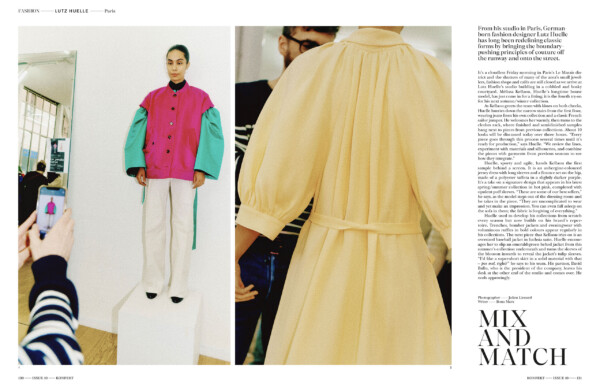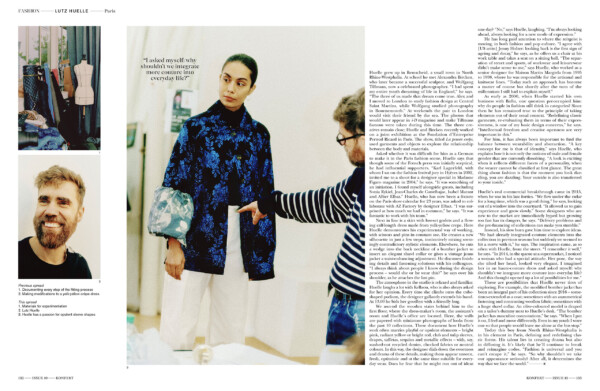Ilona Marx
Editorial work / Concepts / Texts
Mix and Match
Fashion
From his studio in Paris, German-born fashion designer Lutz Huelle has long been redefining classic forms by bringing the boundary-pushing principles of couture off the runway and onto the street.
It’s a cloudless Friday morning in Paris’s Le Marais district and the shutters of many of the area’s small jewellers, fashion shops and cafés are still closed as we arrive at Lutz Huelle’s studio building in a cobbled and bosky courtyard. Mélissa Kellaou, Huelle’s longtime house model, has just come in for a fitting; it is the fourth try-on for his next autumn/winter collection.
As Kellaou greets the team with kisses on both cheeks, Huelle hurries down the narrow stairs from the first floor, wearing jeans from his own collection and a classic French sailor jumper. He welcomes her warmly, then turns to the clothes rack, where finished and semi-finished samples hang next to pieces from previous collections. About 10 looks will be discussed today over three hours. “Every piece goes through this process several times until it’s ready for production,” says Huelle. “We review the lines, experiment with materials and silhouettes, and combine the pieces with garments from previous seasons to see how they integrate.”
Huelle, sporty and agile, hands Kellaou the first sample behind a screen. It is an aubergine-coloured jersey dress with long sleeves and a flounce set on the hip, made of a polyester taffeta in a slightly darker purple. It’s a take on a signature design that appears in his latest spring/summer collection in hot pink, completed with opulent puff sleeves. “These are some of our best sellers,” he says, as the model steps out of the dressing room and he takes in the piece. “They are uncomplicated to wear and yet make an impression. You can even fall asleep on the sofa in them; the fabric is forgiving of everything.”
Huelle used to develop his collections from scratch every season but now builds on his brand’s repertoire. Trenches, bomber jackets and eveningwear with voluminous ruffles in bold colours appear regularly in his collections. The next piece that Kellaou tries on is an oversized baseball jacket in fuchsia satin. Huelle encourages her to slip an emerald-green belted jacket from this summer’s collection underneath and turns the sleeves of the blouson inwards to reveal the jacket’s tulip sleeves. “I’d like a super-short skirt in a solid material with that – pas mal, right?” he says to his team. His partner, David Ballu, who is the president of the company, leaves his desk at the other end of the studio and comes over. He nods approvingly.
Huelle grew up in Remscheid, a small town in North Rhine-Westphalia. At school he met Alexandra Bircken, who later became a successful sculptor, and Wolfgang Tillmans, now a celebrated photographer. “I had spent my entire youth dreaming of life in England,” he says. “The three of us made that dream come true. Alex and I moved to London to study fashion design at Central Saint Martins, while Wolfgang studied photography in Bournemouth.” At weekends the pair in London would visit their friend by the sea. The photos that would later appear in i-D magazine and make Tillmans famous were taken during this time. The three creatives remain close; Huelle and Bircken recently worked on a joint exhibition at the Fondation d’Entreprise Pernod Ricard in Paris. The show, titled La pensée corps, used garments and objects to explore the relationship between the body and materials.
Asked whether it was difficult for him as a German to make it in the Paris fashion scene, Huelle says that though some of the French press was initially sceptical, he had influential supporters. “Karl Lagerfeld, with whom I sat on the fashion festival jury in Hyères in 2002, invited me to a shoot for a designer special in Madame Figaro magazine in 2004,” he says. “It was something of an initiation. I found myself alongside greats, including Sonia Rykiel, Jean-Charles de Castelbajac, Isabel Marant and Alber Elbaz.” Huelle, who has now been a fixture on the Paris show calendar for 23 years, was asked to collaborate with AZ Factory by designer Elbaz. “I was surprised at how much we had in common,” he says. “It was fantastic to work with his team.”
Next in line is a skirt with low-set godets and a flowing calf-length dress made from yolk-yellow crepe. Here Huelle demonstrates his experimental way of working, with scissors and pins in constant use. He creates a new silhouette in just a few steps, instinctively mixing seemingly contradictory stylistic elements. Elsewhere, he cuts a wedge into the back neckline of a bomber jacket to insert an elegant shawl collar or gives a vintage jeans jacket a waist-enhancing adjustment. He discusses finishing details and fastening solutions with his colleagues. “I always think about people I know during the design process – would she or he wear this?” he says over his shoulder, as he attaches the last pin.
The atmosphere in the studio is relaxed and familiar. Huelle laughs a lot with Kellaou, who is also always asked for her opinion. Every time she climbs onto the cube-shaped podium, the designer gallantly extends his hand. At 13.00 he bids her goodbye with a friendly hug.
We ascend the wooden stairs behind him to the first floor, where the dressmaker’s room, the assistant’s room and Huelle’s office are located. Here, the walls are papered with miniature photographs of looks from the past 10 collections. These document how Huelle’s work often marries playful or opulent elements – bright pink, radiant yellow or bright red, club and tulip sleeves, drapes, taffetas, sequins and metallic effects – with, say, washed-out recycled denim, checked fabrics or neutral colours. In this way, the designer dials down the sweetness and drama of these details, making them appear unseen, fresh, optimistic and at the same time suitable for everyday wear. Does he fear that he might run out of ideas one day? “No,” says Huelle, laughing. “I’m always looking ahead, always looking for a new mode of expression.”
He has long paid attention to where the zeitgeist is moving, in both fashion and pop culture. “I agree with [US artist] Jenny Holzer: looking back is the first sign of ageing and decay,” he says, as he offers us a chair at his work table and takes a seat on a sitting ball. “The separation of street and sports, of workwear and leisurewear didn’t make sense to me,” says Huelle, who worked as a senior designer for Maison Martin Margiela from 1995 to 1998, where he was responsible for the artisanal and knitwear lines. “Today such an approach has become a matter of course but shortly after the turn of the millennium I still had to explain myself.”
As early as 2000, when Huelle started his own business with Ballu, one question preoccupied him: why do people in fashion still think in categories? Since then he has remained true to the principle of taking elements out of their usual context. “Redefining classic garments, re-evaluating them in terms of their expressiveness, is one of my basic design concerns,” he says. “Intellectual freedom and creative openness are very important in this.”
For him, it has always been important to find the balance between wearability and abstraction. “A key concept for me is that of identity,” says Huelle, who explains how it is not only the notions of male and female gender that are currently dissolving. “A look is exciting when it reflects different facets of a personality, when the wearer cannot be classified at first glance. The great thing about fashion is that the moment you look dazzling, you are dazzling. Your outside is also transferred to your inside.”
Huelle’s real commercial breakthrough came in 2015, when he was in his late forties. “We flew under the radar for a long time, which was a good thing,” he says, looking out of a window into the courtyard. “It allowed us to gain experience and grow slowly.” Some designers who are new to the market are immediately hyped but growing too fast has its dangers, he says. “Delivery problems and the prefinancing of collections can make you stumble.”
Instead, his slow burn gave him time to explore ideas. “We had already integrated couture elements into the collection in previous seasons but suddenly we seemed to hit a nerve with it,” he says. The inspiration came, as so often with Huelle, from the street. “I remember it well,” he says. “In 2014, in the queue at a supermarket, I noticed a woman who had a special attitude. Her pose, the way she tilted her head, looked very elegant. I imagined her in an haute-couture dress and asked myself: why shouldn’t we integrate more couture into everyday life? And this thought opened up a lot of possibilities for me.”
These are possibilities that Huelle never tires of exploring. For example, the modified bomber jacket has been an integral part of his collection since 2016 – sometimes extended as a coat; sometimes with an asymmetrical fastening and contrasting woollen fabric; sometimes with a huge shawl collar. An olive-coloured model is draped on a tailor’s dummy next to Huelle’s desk. “The bomber jacket has masculine connotations,” he says. “When I put it on, I feel and move differently. Even in my youth I wore one so that people would leave me alone at the bus stop.”
Today this boy from North Rhine-Westphalia is in his element in Paris, defining and redefining classic forms. His talent lies in creating drama but also in diffusing it. It’s likely that he’ll continue to break and reimagine codes. “Fashion is universal and you can’t escape it,” he says. “So why shouldn’t we take our appearance seriously? After all, it determines the way that we face the world.”
Konfekt,
Spring 2023

